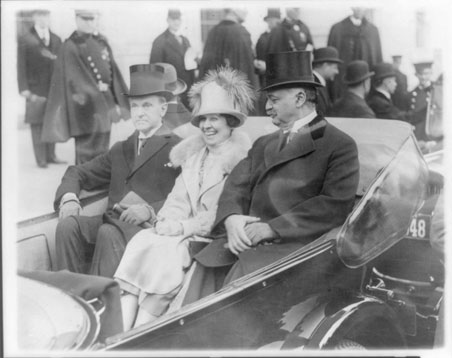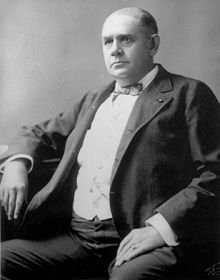History of the Joint Congressional Committee on Inaugural Ceremonies

Photo from the Library of Congress
President Coolidge, Mrs. Coolidge and Senator Curtis on the way to the Capitol, March 4, 1925.
On January 20, 2009, the newly elected President of the United States will take the constitutional oath of office marking the 56th formal Presidential Inaugural ceremony since 1789. In all, U.S. Presidents have been sworn into office 68 times—usually in public, sometimes in private following the death or resignation of a President, or because Inauguration Day fell on a Sunday. While the U.S. Senate oversaw the first 28 Inaugurations of both the President and Vice President, since 1901, all Inaugural ceremonies at the U.S. Capitol have been organized by the Joint Congressional Committee on Inaugural Ceremonies (JCCIC). A separate Presidential Inaugural Committee, appointed by the President-elect, has responsibility for all official Inaugural events other than those held at the Capitol. The military also plays a role with the Armed Forces Inaugural Committee, which coordinates all military participation and support for the Inaugural ceremonies.
Although the United States Constitution specified the oath to be taken by the President, the Framers of the Constitution provided that Congress would determine when and where the Inauguration would take place. As the nation grew, so too did interest in the Presidential Inaugurations. By the late 1820s, what had typically been a small, indoor ceremony moved outdoors, allowing more people to witness this important event first hand. By the end of the 19th century, the Presidential Inauguration had evolved into an elaborate day-long event, marked by parades, fireworks, luncheons, and glamorous Inaugural balls. As the event evolved, so did the Senate's role in the ceremony, and increasingly the House of Representatives became frustrated by their lack of involvement in the planning stage of Presidential Inaugurations.
In March of 1897, as preparations for William McKinley's first Inauguration were underway, members of the House of Representatives protested when they learned Senators would receive twice as many Inaugural tickets. Representatives were further angered when they discovered the Inaugural platform would be built entirely in front of the Senate wing of the Capitol. "In other words," the Washington Post reported, "the House is not to be recognized in this matter even a little bit." Senators defended their actions by reminding their House colleagues that, as a continuing body which advises the President on nominations and treaties, the Senate held a unique position within the federal government, one that was co-equal with the President. The Senate maintained its control over the 1897 Inauguration, but four years later the responsibilities were shared by both houses of Congress.

Library of Congress
Sen. Marcus Hanna
The Joint Congressional Committee on Inaugural Ceremonies was formed in 1901 to oversee Inaugural ceremonies at the United States Capitol. Representatives Joseph Cannon, John Dalzell, and Thomas McRae joined Senators Marcus Hanna, John Spooner and James Jones to plan McKinley's second Inaugural. Hanna chaired the committee, and continued the Senate tradition of accompanying the President-elect on his carriage ride to the Capitol. By all accounts, the joint effort was a success. The 1901 ceremony included parades and exhibitions viewed by the new President from a glass-enclosed reviewing stand at the White House, and the whole event was recorded—for the first time—by motion picture cameras.
Since 1901, Congress has created a new Inaugural committee every four years to plan and conduct the Inaugural activities at the Capitol, including the swearing-in ceremony and the luncheon honoring the President and Vice President. As tradition dictates, the Committee includes the Senate Majority Leader (at the time of appointment), the chair and ranking member of the Senate Committee on Rules and Administration, the Speaker of the House of Representatives and the Majority and Minority Leaders of the House of Representatives.
The current JCCIC was established by resolution (S.Con.Res. 67) on February 28, 2008. Senator Dianne Feinstein of California, Chairman of the Senate Committee on Rules and Administration, chairs the committee. Other members include Senators Harry Reid of Nevada and Bob Bennett of Utah, as well as Speaker of the House Nancy Pelosi of California and Representatives Steny Hoyer of Maryland and John Boehner of Ohio.

